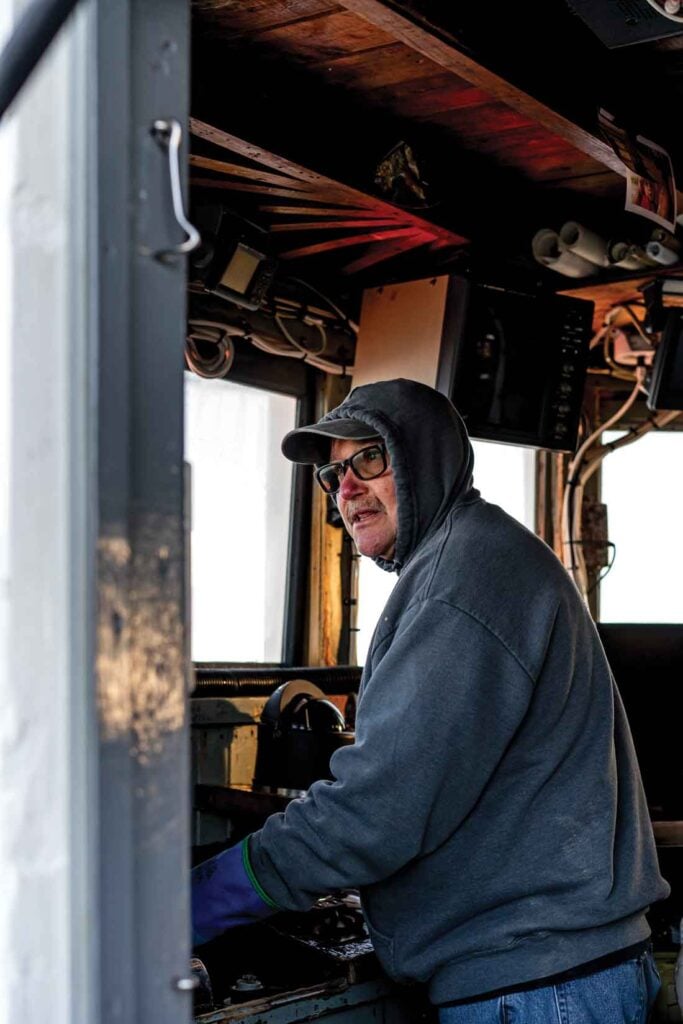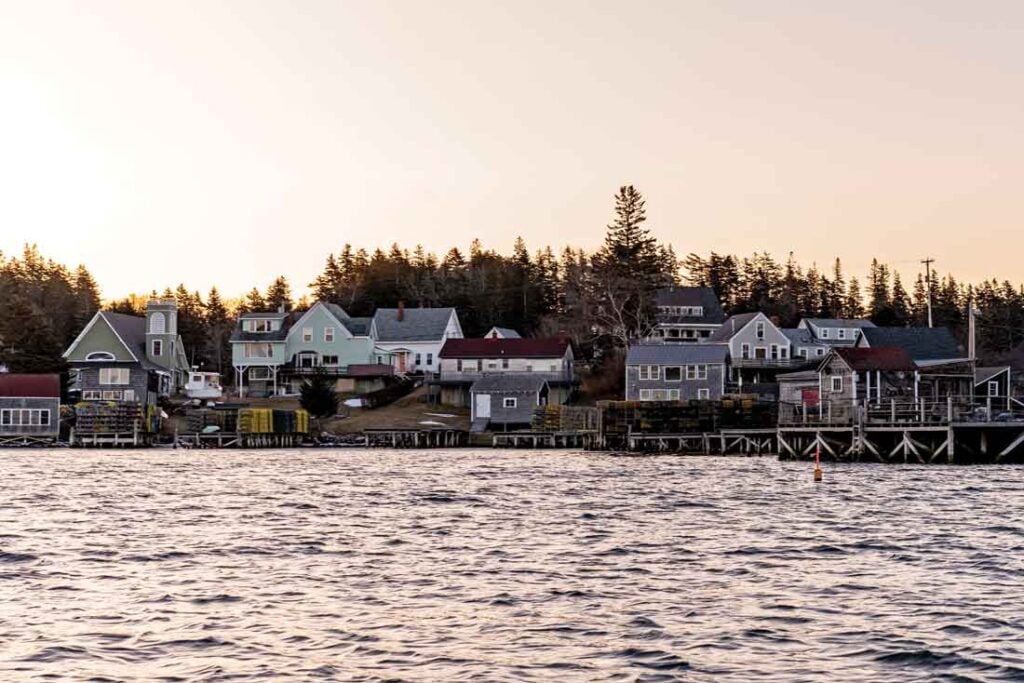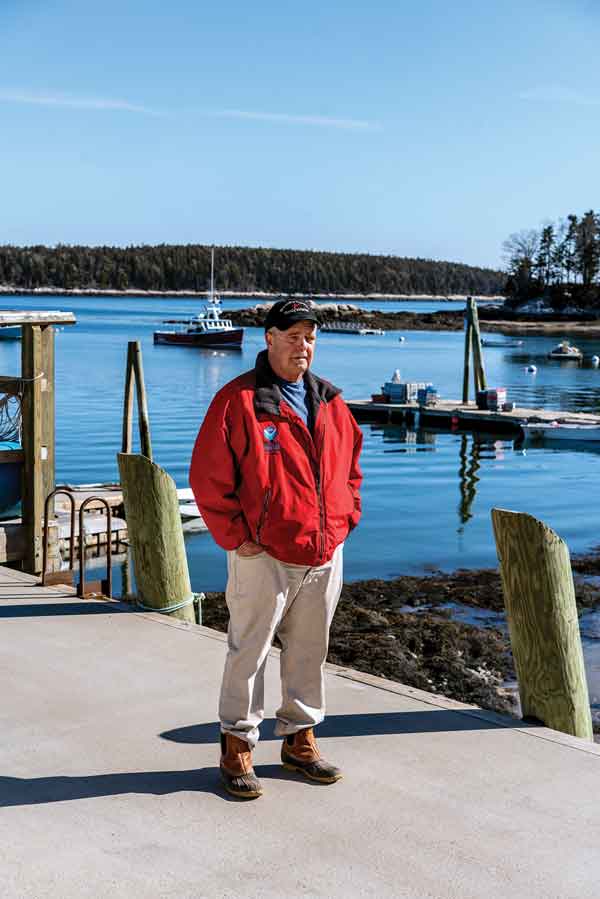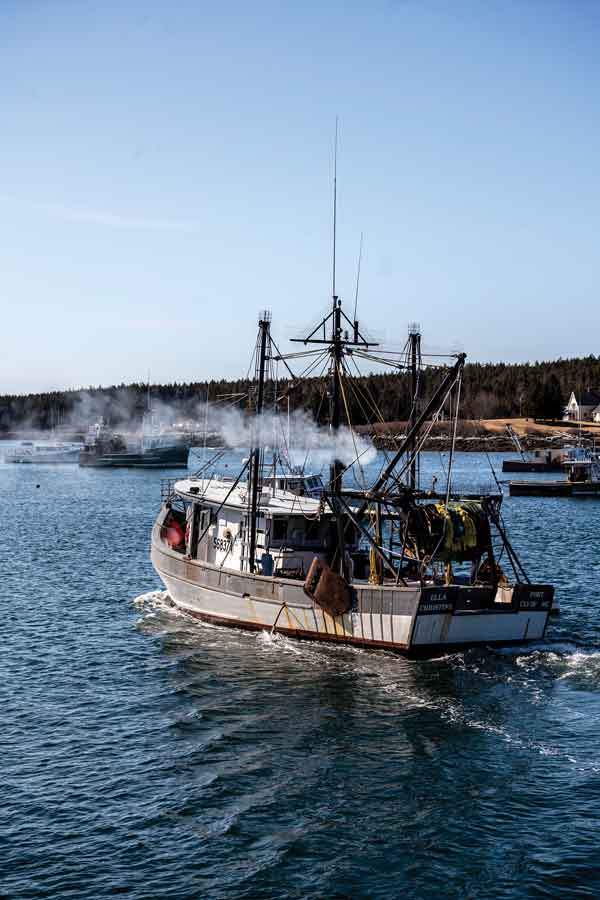
By Susan Conley
Photographed by Ryan David Brown
From our May 2021 issue
When Randy Cushman was growing up in Port Clyde, some 300 trawlers were moored up and down Maine’s coast, most of them square-sterned draggers that went out a day or two at a time looking for flatfish, like flounder and dabs. One such boat belonged to Cushman’s father, Captain Lee Cushman, a third-generation Port Clyde boatbuilder and a fishing legend around the peninsular midcoast village. Boats were Cushman’s classroom, whether he was behind the wheel or fishing up on deck. Summers, holidays, weekends — his father needed him. By the time he turned 18, Cushman could run a 100-foot trawler. At 20, he became a captain.
Today, Cushman is 59 years old and might be Maine’s most knowledgeable commercial fisherman. Ben Martens, director of the Maine Coast Fishermen’s Association, calls him “the iconic fisherman, one of the smartest guys I know in the industry.” But Cushman is barely scraping by. Prices for cod, flounder, and other groundfish have all but collapsed in Maine. The combination of rock-bottom prices, the need to protect the state’s fish stocks, and a dearth of fishing infrastructure make it harder than ever to be a fisherman here. Today, the robust Maine trawler fleet of Cushman’s youth has been reduced to around 30 boats.
Cushman remembers when just about everyone in Port Clyde was involved in fishing somehow, when nearly all the homes that sit above the harbor had fishing families living in them. The hamlet at the end of the St. George peninsula had several icehouses and gear shops, a sardine factory, a clam factory, even a gas station. They’re all gone now, as are the tractor trucks that came and went, filled with fish. Back then, Cushman knew everyone, and he and his three younger brothers could walk into a half-dozen houses for penny candy without knocking. Moored in the narrow gut between Port Clyde and Hupper Island were more than 20 trawlers.

he sees the value in changing. Getting fishermen to change their practices is really, really hard.”
I too remember the trawlers, in a harbor town several peninsulas over. Growing up, I never questioned these boats in the harbor, the way I never questioned the granite rocks or the gray-blue sea or the conical green pines. The trawlers were part of Maine, and Maine was part of the trawlers, and both of their survivals depended on one another. It has taken me until now to try to understand where those boats went. Their disappearance unfolded across many years, but if, like many in Maine, you weren’t paying close attention, it may have felt like it happened overnight, the way you can look up sometimes and realize that something you care about deeply has been in the act of vanishing the whole time you’ve been watching it. Today, there are three trawlers left in Port Clyde’s harbor. Randy Cushman owns the only one that fishes year-round.
One morning last October, Cushman climbed up the ladder from the engine room of his 42-foot boat, the Ella Christine, and waved me aboard. He wore old jeans, a gray sweatshirt, and a baseball cap, and he told me through a face mask he’d been doing electrical work down below. Cushman has owned the white-hulled boat for 25 years, though it was built in 1975, and he and his wife, Melony, are forever fixing wires and replacing parts, trying to keep up with repairs. “Being a captain of one of these boats, you need to be a plumber, mechanic, and electrician,” Cushman said. He spoke in a steady, measured cadence. “This boat is 20 times more complicated than my home. A very complicated piece of machinery. But the boat has to bring you back at the end of the day.”
He walked me to the stern, where he pointed out the Ella Christine’s enormous winch, with miles of mesh netting wrapped around it. Attached to the net were thick rubber discs made from car tires that allow it to float above the seabed, like a kite, rather than dragging the ocean floor. “So this is not rototilling, like people may think,” Cushman said. “The nets are neutral buoyancy. If I lose one off my boat, it would take days and days for it to sink. It doesn’t want to sink.” A single net, he said, can cost anywhere from $8,000 to $20,000. Sturdy cables connected the net to the winch on either side, and attached to the cables were large steel panels, known as trawl doors. Down near the ocean floor, the doors spread like wings, opening the net up wide. Cushman tows the net between 3 and 4 miles before hauling it in, hopefully full of fish.
For 38 years, Cushman has fished for flounder, a thin, diamond-shaped species that lives near the bottom of the ocean. “Flounder are my bread and butter,” he told me, “and there is no other method to catch them than nets.” His youngest brother, Gerry Cushman, says Randy’s nets are the most efficient in the Northeast, adjusted for fuel-efficient drag and designed to limit bycatch. During an entire three-day trip, Cushman says, he might net just one lobster; an occasional skate, crab, or dogfish; and 10 to 15 juvenile fish, all of which he throws back into the sea.
He put a hand through one of his net’s diamond holes. “This hole is so big that the smaller fish swim right out,” he said. “The biggest thing we did for fish conservation in Maine was to enlarge the hole.” For years, Cushman has experimented with different calibrations of mesh, sometimes partnering with scientists from the Nature Conservancy. He swears by a 6½-inch mesh size — a half inch larger than federal law requires, because he doesn’t care to catch small fish he can’t get a good price for.




From the nets, the fish go into what Cushman calls the dumping pen, where they’re measured in front of a video camera. Cushman started using the camera three years ago, part of a pilot program in electronic monitoring — “EM,” in fishermen’s parlance — developed with the Nature Conservancy, the Gulf of Maine Research Institute, and other organizations. Last year, the New England Fishery Management Council mandated 100 percent observer coverage on Maine’s fleet, as a way to prevent misreported catches. “You get to pick: human or EM,” Cushman said, gesturing at the camera. “I’ll choose a camera all day over another person on a small vessel like mine. Plus, there’s no bias on a camera.” Fishermen in Maine these days are always thinking about how to create better practices, he said. “It’s a lot different than the old days, when my father and grandfather fished.”
Cushman is just old enough to remember when the Gulf of Maine was the Wild West of fishing. In the 1960s and into the ’70s, there was no such thing as a catch limit, and the fishery was crowded with foreign “factory ships,” huge vessels with onboard processing and freezing facilities. Congress put a stop to unregulated foreign fishing in 1976, passing the Magnuson–Stevens Act. The landmark law protected American fisheries by extending U.S. territory 200 nautical miles from shore, and it wrought enormous changes on Maine’s commercial fishing industry: the creation of regional councils to enforce catch limits, restrictions on how many days fishermen could spend at sea, and, eventually, fish quotas, percentages of which were allocated to cooperative sectors of regional fishermen based on members’ landing history.
But many of the stocks were already decimated, and one by one, Maine trawlers began dropping off. Then, many of the state’s processing plants, boat shops, and icehouses folded, making it even tougher to turn a profit and creating a domino effect. Around Port Clyde, Cushman says, “all the big boats sold or left.”
“My father used to scream at other fishermen who sold out,” Cushman remembers. “He would have it out with them — good friends who grew up with him and had their boats and properties handed down to them from their fathers. They sold out, and my father disowned them.”




Captain Lee died of cancer in 1995, at 52. A year later, Cushman bought the Ella Christine, and he wishes his father had been around to see him with his own trawler. “My father had so many talents,” Cushman says. “He fished all species, and if he didn’t build your boat, then he rebuilt it. He was very well known around here.” Captain Lee’s four sons carry on their father’s tradition. Each of Cushman’s three younger brothers — Dennis, Michael, and Gerry — have had a foot in groundfishing although they’re primarily lobstermen now. Gerry maintains a permit for every fishery in the Northeast (you can’t count on just one species, he says).
Cushman dabbled in lobstering as a teenager, but his heart has been always in groundfishing. He feels drawn to offshore waters, he says, “where you don’t see land.” Today, he couldn’t make the switch even if he wanted to, not easily anyway, as the waiting list for a commercial lobster-fishing license can stretch more than 10 years.
Cushman walked me inside the Ella Christine’s little wheelhouse, his home away from home. I looked at the minuscule sink where he does the dishes, then at the postage-stamp countertop and two-burner stove. I saw the bunk beds, the nine different fire extinguishers, and the shelves of first-aid equipment, enough bandages and ointments and salves and anti-inflammatories to patch up a football team. Cushman took it all in for a moment, then murmured, “You’re only as good as your boat.”

Out the windows, lobsterboats bobbed in the harbor. These days, Port Clyde is mostly a lobster town. In recent years, some 70 licensed Port Clyde lobstermen have brought in a catch worth $6 to $7 million annually. In 2019, meanwhile, the last year for which data is available, landings for Maine’s entire commercial groundfishery — that is, statewide — were valued at only around $4 million.
“There’s no sugarcoating it,” Cushman told me. “There’s a lot of heartache, so if your heart’s not in it, you won’t make it. You’ve got to love the ocean and respect the ocean and respect the fishery. But I have no regrets. If I don’t fish, it will probably be the end of fishing in Port Clyde.”
Cushman bought the Ella Christine in 1996 from another Maine fishing legend, Terry Alexander, who sits on the New England Fishery Management Council, one of eight regional councils established by the Magnuson–Stevens Act. Cushman and Alexander speak highly of each other. Last September, Alexander invited me onto his porch in Cundy’s Harbor to explain Maine’s commercial fishing hurdles from his vantage on the NEFMC.

According to him, one of the biggest complaints Maine fishermen have right now is with “trawl surveys” conducted by the National Marine Fisheries Service, or NOAA Fisheries, semiannual samplings of fish stocks intended to gauge a population’s health. Alexander says they don’t yield accurate results. For starters, he says, the 20-minute trawls are comically short and carried out from a 208-foot research boat, a vessel way too large to get accurate groundfish readings. Plus, Alexander says, the surveyors don’t change nets according to which fish species they’re counting, which is sacrosanct in commercial fishing. You’ve got to change your net.
“The trawl survey needs to be fixed so the federal scientists get real numbers,” Alexander says. “Right now, science is telling us one thing, and the fishermen are telling us something else.” Namely, that fish stocks are healthier than government scientists believe.
What’s more, Alexander questions some aspects of resource managers’ vision of what a recovering fishery looks like. When NOAA Fisheries determines a stock is overfished, the agency and the regional councils enact plans to rebuild it, enforcing catch limits to meet biomass targets that allow for what managers call “maximum sustainable yield.” But managers are aiming to hit those targets with many species all at once, Alexander points out, and he doesn’t believe ecosystems behave in a way to facilitate this. “It sounds good in your senate chamber in DC,” he says, “but Mother Nature doesn’t work that way. One species is up. The other is down.”
Perhaps surprisingly, Cushman’s recent struggles have little to do with lack of fish. Some days, he says, he sees more flounder than he has in decades. What’s lacking is demand and a decent price per pound for his flounder. “People aren’t buying Maine fish,” he told me. “It was already like this before COVID. Now, it’s worse. Some days, the buyers tell me to not even go out.”

Cushman drives more than two hours south to sell his fish at the Portland Fish Exchange, Maine’s only remaining fish auction, which last year was losing some $30,000 a month on account of declining volume. He remembers when a dozen buyers would show up to bid for his catch. These days, there are six. Meanwhile, human fish cutters at the exchange have been replaced by machines, which both Cushman and Alexander say don’t get the same yield — and for a thin fish like flounder, yield is everything.
Cushman and Alexander agree that Maine’s groundfishing industry has a messaging problem. “We are the most regulated and monitored fishing industry in the world,” Alexander says. “That Maine fish you’re thinking of buying? It’s sustainable. We have vast stretches of ocean closed in and around Maine. We have spawning grounds closed. We have the most monitoring in the world and the largest mesh size. Buy Maine fish. Go out of your way to do it.”
Back in the Ella Christine wheelhouse, Cushman showed me four different computer screens on a shelf in front of the captain’s chair, each a different kind of GPS. A radar beacon nailed to the wall continuously transmits the boat’s whereabouts to NOAA, he explained, and he pointed out a black button that would alert boats in the area if he was in trouble and couldn’t get a mayday out. Later that morning, he was planning to install a new navigational light on his mast, one that would signal to other boats that the anchored Ella Christine was not under command when he was asleep. Cushman’s profit margins these days are small enough that he can’t afford a crew, and he was planning to fish alone come winter.
“The new light will show the other boats that I’m sleeping,” he said. “If I’m out there two or three days by myself, I’m going to need to get some rest.”
Cushman was 34 when he bought the Ella Christine from Alexander. He went to the bank with a business plan, and because he grew up in the fishery and could talk the language, he got the loan. “Now, a 32-year-old could never buy this boat,” he said. “It costs way, way too much. You have to have stability in the market to get a loan, but we don’t have that anymore.”
A few years ago, Cushman counted up how much he’d paid to keep the Ella Christine going that year — fuel, gear, repairs, ice, taxes, and more. He arrived at a number around $200,000, which he says made it a middle-of-the-road expense year — not his most expensive, not his cheapest. He estimates his overhead costs have tripled since he started fishing. “But a dollar difference makes you or breaks you,” he says. “You’ve caught all the fish you’re allowed to catch on your quota, and you’re still in the negative. So now you’re losing money. Catching fish is the easy part.”
In some ways, Cushman is lucky to be in Port Clyde, where a fishermen’s co-op his father and grandfather helped found owns a wharf and a deepwater dock that can never be sold. In other Maine fishing towns, where the shoreline has been bought up for residential and other non-marine uses, fishermen can’t contend with high real-estate prices and property taxes, and they’re losing spots to launch their boats, park their vehicles, store gear, and run marine businesses. Fifteen years ago, Cushman and his brother Gerry were among a group of Port Clyde fishermen who started what’s now known as the Maine Coast Fishermen’s Association. Founded in Gerry’s living room, the nonprofit works to preserve the state’s working waterfronts and the health of the fishery.

Cushman heads out on the Ella Christine. Despite the industry’s hurdles, he isn’t ready to give up on it. “You always have to have hope,” Cushman says.
Recently, MCFA teamed up with the Nature Conservancy and Island Institute to buy commercial fishing permits as Maine fishermen retire. Many of these permits, which are limited in number and typically sell for hundreds of thousands of dollars, were being bought up by out-of-state fishermen. (“Lord knows we would never get them back,” Cushman says, “and without groundfish permits here, you close a door that you may never be able to open again.”) Last year, the organization launched a grant-funded program to buy fish from Maine fishermen at guaranteed prices and donate it to Maine schools, food banks, and other community organizations. MCFA executive director Ben Martens says Maine needs such creative efforts to preserve the Gulf of Maine’s fishery and the state’s fishing heritage.
“There will always be fishing in the Gulf of Maine,” he says. “Always. It’s one of the most productive waters in the world. We’ve been harvesting fish from it for over 500 years, and there are still fish in it. But let’s protect our state’s working waterfronts while the fisheries rebuild.” Martens points to the rebound of Maine haddock and scallop stocks as success stories. And while lobstering may be a thriving industry, he warns, Maine fishing towns shouldn’t bank on a single species. “A diverse fishery is what will save a community,” Martens says.
On his porch in Cundy’s Harbor, Alexander told me he worries about a day when Maine’s fishing villages have all become tourist stops, where the harbors are full of pleasure boats, and “locals are scarcer than hen’s teeth.” I worry too. People say they come to Maine for its authenticity and in appreciation of the idea that real work still means something here. So what will Maine be like if all the trawlers are gone, if we only have postcards of them?
Cushman and I stepped out of the wheelhouse, and I asked him if he could imagine Maine without groundfishing. He really couldn’t, he said. The way Cushman sees it, he has about 10 years left to fish, and he wants to leave more than he started with for the generations that come after him. He has two adult kids who help him whenever they can — offloading fish, say, when he returns from a trip — but his son works in social services and his daugher is an artist. One of Cushman’s granddaughters, however, 7-year-old Ellie Mae, is “showing signs of being a natural in the skiff,” and several of his brothers’ kids are already lobstering out of Port Clyde. Gerry’s two kids, at 14 and 11, are often seen hauling traps in a 20-foot skiff.
“I’ll get to leave my boat and my permits behind for my family, but it’s the actual money that scares me,” Cushman said. “If the money was decent, so many more people would go into fishing. But I will go down fighting. I’m stubborn as could be, and I’m not willing to give up.”
Cushman sometimes imagines winning the lottery. The first thing he’d do, he told me, is build a new trawler, one perfectly suited for Port Clyde’s high winds and strong currents. Then, he’d teach a young person in town everything they need to know about fishing, which he thinks would take a couple of years. After that, he said, he would retire — but first, he would have an agreement in place that the person he’s left the boat to has to keep fishing. “I’ll have the contract drawn up,” he said, and he smiled. “They can only ever fish.”
